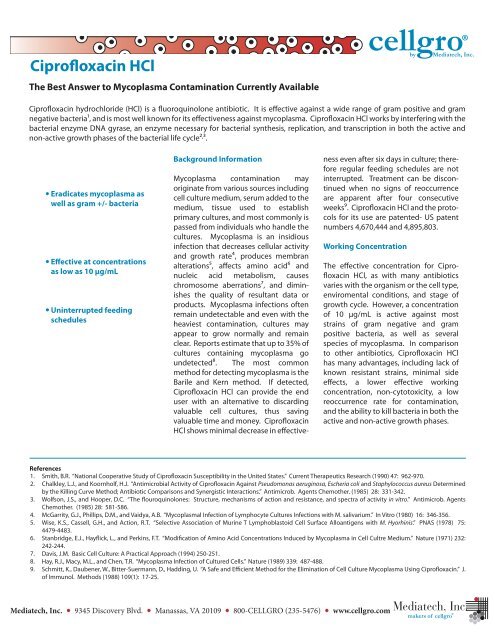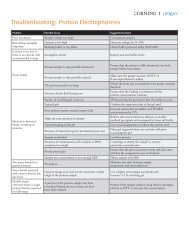Working with Ciprofloxacin HCl - Cellgro
Working with Ciprofloxacin HCl - Cellgro
Working with Ciprofloxacin HCl - Cellgro
You also want an ePaper? Increase the reach of your titles
YUMPU automatically turns print PDFs into web optimized ePapers that Google loves.
<strong>Ciprofloxacin</strong> <strong>HCl</strong><br />
The Best Answer to Mycoplasma Contamination Currently Available<br />
Mediatech, Inc. 9345 Discovery Blvd. Manassas, VA 20109 800-CELLGRO (235-5476) www.cellgro.com<br />
cellgro®<br />
by Mediatech, Inc.<br />
<strong>Ciprofloxacin</strong> hydrochloride (<strong>HCl</strong>) is a fluoroquinolone antibiotic. It is effective against a wide range of gram positive and gram<br />
negative bacteria¹, and is most well known for its effectiveness against mycoplasma. <strong>Ciprofloxacin</strong> <strong>HCl</strong> works by interfering <strong>with</strong> the<br />
bacterial enzyme DNA gyrase, an enzyme necessary for bacterial synthesis, replication, and transcription in both the active and<br />
non-active growth phases of the bacterial life cycle2,3.<br />
References<br />
1.<br />
2.<br />
3.<br />
4.<br />
5.<br />
6.<br />
7.<br />
8.<br />
9.<br />
Eradicates mycoplasma as<br />
well as gram +/- bacteria<br />
Effective at concentrations<br />
as low as 10 μg/mL<br />
Uninterrupted feeding<br />
schedules<br />
Background Information<br />
Mycoplasma contamination may<br />
originate from various sources including<br />
cell culture medium, serum added to the<br />
medium, tissue used to establish<br />
primary cultures, and most commonly is<br />
passed from individuals who handle the<br />
cultures. Mycoplasma is an insidious<br />
infection that decreases cellular activity<br />
and growth rate4, produces membran<br />
alterations5, affects amino acid6 and<br />
nucleic acid metabolism, causes<br />
chromosome aberrations7, and diminishes<br />
the quality of resultant data or<br />
products. Mycoplasma infections often<br />
remain undetectable and even <strong>with</strong> the<br />
heaviest contamination, cultures may<br />
appear to grow normally and remain<br />
clear. Reports estimate that up to 35% of<br />
cultures containing mycoplasma go<br />
undetected8. The most common<br />
method for detecting mycoplasma is the<br />
Barile and Kern method. If detected,<br />
<strong>Ciprofloxacin</strong> <strong>HCl</strong> can provide the end<br />
user <strong>with</strong> an alternative to discarding<br />
valuable cell cultures, thus saving<br />
valuable time and money. <strong>Ciprofloxacin</strong><br />
<strong>HCl</strong> shows minimal decrease in effective-<br />
ness even after six days in culture; therefore<br />
regular feeding schedules are not<br />
interrupted. Treatment can be discontinued<br />
when no signs of reoccurrence<br />
are apparent after four consecutive<br />
weeks9. <strong>Ciprofloxacin</strong> <strong>HCl</strong> and the protocols<br />
for its use are patented- US patent<br />
numbers 4,670,444 and 4,895,803.<br />
<strong>Working</strong> Concentration<br />
The effective concentration for <strong>Ciprofloxacin</strong><br />
<strong>HCl</strong>, as <strong>with</strong> many antibiotics<br />
varies <strong>with</strong> the organism or the cell type,<br />
enviromental conditions, and stage of<br />
growth cycle. However, a concentration<br />
of 10 μg/mL is active against most<br />
strains of gram negative and gram<br />
positive bacteria, as well as several<br />
species of mycoplasma. In comparison<br />
to other antibiotics, <strong>Ciprofloxacin</strong> <strong>HCl</strong><br />
has many advantages, including lack of<br />
known resistant strains, minimal side<br />
effects, a lower effective working<br />
concentration, non-cytotoxicity, a low<br />
reoccurrence rate for contamination,<br />
and the ability to kill bacteria in both the<br />
active and non-active growth phases.<br />
Smith, B.R. “National Cooperative Study of <strong>Ciprofloxacin</strong> Susceptibility in the United States.” Current Therapeutics Research (1990) 47: 962-970.<br />
Chalkley, L.J., and Koornholf, H.J. “Antimicrobial Activity of <strong>Ciprofloxacin</strong> Against Pseudomonas aeruginosa, Escheria coli and Staphylococcus aureus Determined<br />
by the Killing Curve Method; Antibiotic Comparisons and Synergistic Interactions.” Antimicrob. Agents Chemother. (1985) 28: 331-342.<br />
Wolfson, J.S., and Hooper, D.C. “The flouroquinolones: Structure, mechanisms of action and resistance, and spectra of activity in vitro.” Antimicrob. Agents<br />
Chemother. (1985) 28: 581-586.<br />
McGarrity, G.J., Phillips, D.M., and Vaidya, A.B. “Mycoplasmal Infection of Lymphocyte Cultures Infections <strong>with</strong> M. salivarium.” In Vitro (1980) 16: 346-356.<br />
Wise, K.S., Cassell, G.H., and Action, R.T. “Selective Association of Murine T Lymphoblastoid Cell Surface Alloantigens <strong>with</strong> M. Hyorhinis.” PNAS (1978) 75:<br />
4479-4483.<br />
Stanbridge, E.J., Hayflick, L., and Perkins, F.T. “Modification of Amino Acid Concentrations Induced by Mycoplasma in Cell Cultre Medium.” Nature (1971) 232:<br />
242-244.<br />
Davis, J.M. Basic Cell Culture: A Practical Approach (1994) 250-251.<br />
Hay, R.J., Macy, M.L., and Chen, T.R. “Mycoplasma Infection of Cultured Cells.” Nature (1989) 339: 487-488.<br />
Schmitt, K., Daubener, W., Bitter-Suermann, D., Hadding, U. “A Safe and Efficient Method for the Elimination of Cell Culture Mycoplasma Using <strong>Ciprofloxacin</strong>.” J.<br />
of Immunol. Methods (1988) 109(1): 17-25.
<strong>Working</strong> <strong>with</strong> <strong>Ciprofloxacin</strong> <strong>HCl</strong><br />
Mediatech, Inc. 9345 Discovery Blvd. Manassas, VA 20109 800-CELLGRO (235-5476) www.cellgro.com<br />
cellgro®<br />
by Mediatech, Inc.<br />
<strong>Ciprofloxacin</strong> <strong>HCl</strong> powder should be stored at room temperature below 30°C. Liquid stock solutions should be stored frozen<br />
(-20°C).<br />
To prepare a stock solution add the appropriate amount of powder to distilled deionized water while mixing.<br />
NOTE: Adding water directly to the powder may result in insoluble mixtures that cannot be filtered <strong>with</strong>out losing potency.<br />
After ensuring that the mixture is completely solubilized, filter sterilized. Store at -20°C. If desired, the pH may be adjusted.<br />
Media containing freshly added <strong>Ciprofloxacin</strong> <strong>HCl</strong>, at an effective working concentration of 5-25 μg.mL (most commonly 10<br />
μg/mL), should be added to cells seeded at a density of 103 to 105.<br />
Cells should be re-seeded or sub-cultured <strong>with</strong> media containing <strong>Ciprofloxacin</strong> <strong>HCl</strong> at 3 to 4 day intervals.<br />
Cells should be treated for 12-20 days, after which, it is no longer necesary to include <strong>Ciprofloxacin</strong> <strong>HCl</strong> in the media.<br />
<strong>Ciprofloxacin</strong> <strong>HCl</strong> may be used in combination <strong>with</strong> other antibiotics.<br />
<strong>Ciprofloxacin</strong> <strong>HCl</strong> is soluble in water. Stock concentrations of up to 10 mg/mL frozen can be safely recommended as far as long<br />
term storage of liquid solution.<br />
Product Catalog No. Size<br />
<strong>Ciprofloxacin</strong> <strong>HCl</strong>, Powder 61-277-RF<br />
61-277-RG<br />
1 x 1 g<br />
1 x 5 g



